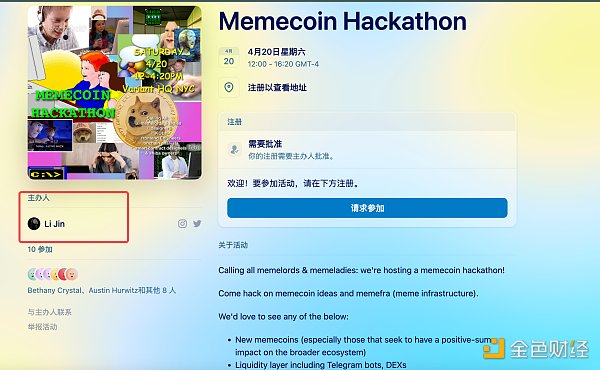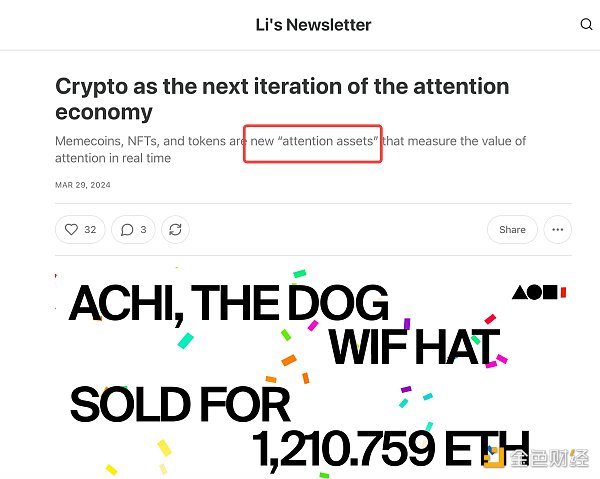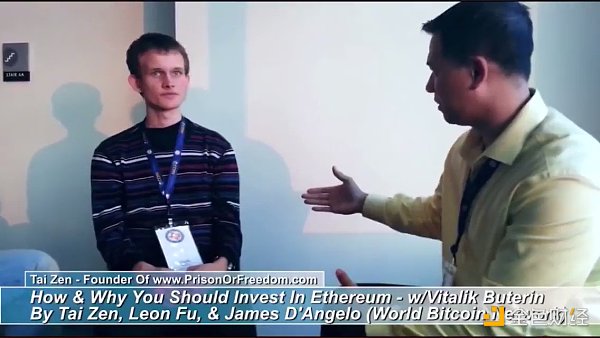Author: TechFlow
Users are not afraid of sharp rises and falls, but they are afraid that I don’t have a better chance to enjoy the sharp rises and falls than you.
Usually in the eyes of leeks, VC is a booster of the sickle, and Meme is a big red flag against the sickle.
Memes driven by culture and community often do not have too much primary investment and endorsement by big VCs. The relatively fair and random characteristics have also made "Chongtugou" gradually become a carnival for leeks --- it’s better to bet on the Meme lottery warehouse since it’s a cut anyway.
It’s just that this carnival has not belonged to VC for a long time.
VCs with top-level foresight and vision can naturally see the change in the direction of the crypto circle. Whether you are anxious or thinking, you have to do something to seek breakthroughs in the big wave of attention economy.
Recently, Li Jin, co-founder of Variant, started to take action and wrote on his Twitter:
"Born too late, you can't explore the earth; born too early, you can't explore the universe; born at the right time, hold a meme hackathon."

This event, called Memecoin Hackthon, is hosted by Li Jin on the introduction page and is scheduled to be held on April 20 at the headquarters of Variant Fund in New York, calling on teams that can build the following aspects to participate:
New meme coins, especially those seeking to have a positive-sum impact on the broader ecosystem
Liquidity layer, including Telegram robots, DEX
Applications using memecoins as a GTM strategy
Around memecoin builds utility applications
It is interesting to note that a word called "Memefra" was mentioned in the event, which means Meme infrastructure. Let teams with ideas and capabilities build Memefra. It is obvious that VCs also welcome everything that creates conditions for Meme.
Born at the right time, are VCs who have always been high-end infrastructure technology streams really going to start catching up with the Meme wave with its own dog temperament in a timely manner?
Attention economy, perpetual motion machine in the currency circle
In fact, VC co-founded the Meme hackathon not on a whim, but more of a matter of following the trend.
VC investment emphasizes value return, and Meme itself has "attention value".
In Li Jin's earlier blog, he was very keenly aware that Memecoin,NFT and tokens are new "attention assets" that can measure the value of attention in real time.

Rich information will cause a lack of attention, so attention is a scarce resource. However, in the advertising business model dominated by Web2, the value brought by user attention is harvested by the platform rather than flowing to the user.
Therefore, cryptocurrency can be regarded as the next generation iteration of the attention economy, with a more efficient market.
Memecoin can measure and capture the value of attention in real time. Users can invest and own attention assets to express their beliefs on whether a particular Meme, media, creator, or network will gain more attention and interest in the future.
From this point of view, it becomes more reasonable for VCs to favor Meme coins.
After all, it is quite tempting and persuasive to successfully invest in products that can capture the attention of the public (even if it is a Meme).
While attracting users' attention, the emergence of Meme also taught a lesson to many crypto projects in terms of marketing methods and listing rhythm:
In the traditional model, crypto projects follow the path of "product first, attention later" --- first build a product through technology, then build a community around it through marketing, become known and gradually develop;
In the Memeattention economy, crypto projects can completely "attention first, product later" --- by launching a project that is natively integrated with the popular memecoin, new applications/infrastructures can mobilize the memecoin holder base, who can experience more practicality from their tokens.
Two different development ideas, and it is obvious that the times have chosen the latter.
No matter what kind of crypto project it is, it is essentially attracting attention, allowing more people to participate and use it, and allowing more people to connect with the token.
Driven by the attention economy, the cryptocurrency industry has gone through many stages, from Bitcoin to Ethereum, from NFT to Meme. A round of narrative change is a shift of attention.
Therefore, it is not surprising that VCs revolve around attention and make timely changes.
Users are educated by VCs, and users also educate VCs
However, you have to know that the former crypto market was not dominated by the Meme carnival without a background, but followed the traditional and serious venture capital path.
When Ethereum was first born in the early years, in 2014, even Vitalik had to do a project roadshow and explanation of Ethereum to various investors from the East and the West.

Although veterans in the cryptocurrency circle often recall that "no one understood Ethereum at the time, and now it seems that they have broken their thighs if they don't invest", as strong as Vitalik, crypto projects have always followed the same process: first use strength (or bragging about strength) to impress the attention of VCs, and then go to the market to grab (or harvest) the attention of users.
In this path, whether it is ICO or IEO, VCs get a lot of low-priced chips with the advantage of early rounds, and then sell them according to different unlocking conditions when the project moves to the secondary stage; of course, there are smart retail investors who follow suit to eat meat and drink soup, but there are also a lot of receivers who take over the last baton.
After a long time, they get tired; after a round of education, users can probably understand what is going on.
So we can see more and more projects such as inscriptions, runes and Memecoin in the new cycle that VCs do not participate in, do not have time to participate in, or disdain to participate in. They have broken the above-mentioned inherent venture capital process and the path of attention growth:
First use explosive pull to directly impress users' attention, and then do other things based on the user base.
Users are not afraid of sharp rises and falls, but they are afraid that I don’t have a better chance to enjoy the sharp rises and falls than you. Obviously, Memes have given users a relatively closer channel. Even if they will be cut, it is better than being clearly taken over by VCs.
So to some extent, users are also educating VCs in turn, adults, times have changed.
It is interesting to see a role exchange between the upstream and downstream of the ecological chain, and this is also the interesting part of the currency circle:
Cutting and hurting each other, and growing together.
 JinseFinance
JinseFinance
 JinseFinance
JinseFinance JinseFinance
JinseFinance JinseFinance
JinseFinance JinseFinance
JinseFinance JinseFinance
JinseFinance JinseFinance
JinseFinance JinseFinance
JinseFinance 链向资讯
链向资讯 链向资讯
链向资讯 Bitcoinist
Bitcoinist